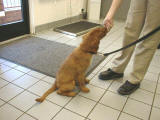Becoming the "The Cookie Place!"
 Your
Mission this week -
should
you choose to accept
- is to transform your
location into, "The Cookie Place!"
Your
Mission this week -
should
you choose to accept
- is to transform your
location into, "The Cookie Place!"
1.
Ask clients to bring pets in hungry -
that means skipping the meal prior to the visit. Also ask
clients to bring in a ziplock baggie of the pet's favorite food
treat (ideally one that the pet only gets at your location.)

IMPORTANT: Very small, young breeds with a
tendency to low blood sugar such as an 8 week old Chihuahua
should be fasted no more than 3 - 4 hours.
2. Make sure there is a
supply of treats handy in many locations
to allow your team and volunteers to greet all pets with a
treat in their hands!
Encourage ALL team members to
keep treats in their pockets
using ziplock
baggies to keep treats fresh.
3. Stock a variety
- at least 3 types of treats - from low to high appeal to
evaluate the pet's stress. For example, if the pet does not take
a piece of kibble, offer freeze dried liver. If the pet will not
take a high appeal treat, then consider the pet is too stressed to eat.
Examples of Low to High
Value Treats
- baby food on tongue depressors (cats)
- canned Cheez-Whiz on exam table
(cats and dogs)
-
freeze-dried liver
(cats and dogs)
- honey-nut cheerios
(dogs)
- Hills,
Butler
or commercial jerky treats
(dogs)
4.
Remind your team to
use body language
to lower threat -
not to face pets directly but to turn to
the side, and offer an outstretched hand for the pet to
approach.
IMPORTANT: Give VERY small (cheerio size) treats.
5.
Use treats as
distractions from injections
and minor treatments and to demonstrate to pet parents how
lure pets with treats into a sit position, releasing the treat
as the reward.
Q: Why use "cookies" and "distractions" to prevent pet
fears?
A: When pets develop fears or
veterinary phobias, clients are less likely to bring them in for
veterinary care or give them all recommended care. Fearful pets
put veterinary teams at risk for animal bites.